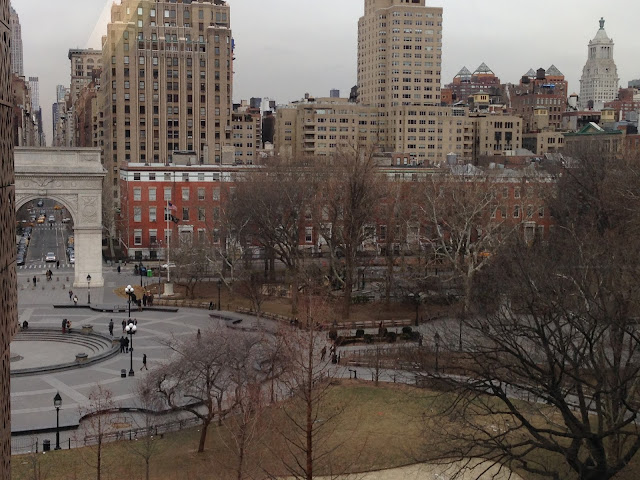The most famous site here is the Washington Square Arch, about midway along the block and right in front of where Fifth Avenue ends. Here's a look at that spot from a building on the southern border of the park:
The arch was completed in 1892 and is a commemoration of the 100th anniversary of George Washington's presidential inauguration in 1789.
Here's a look from inside the park facing north:
Although the arch is a stereotypical tourist attraction, it is also a nice structure and hard not to notice when you're in the area, including walking along Washington Square North:
Turning to other sites on the block, would anyone like to see a semi-famous tree?... I'll take that as a "yeah, okay."
At the northwest corner of the park is the Hanging Tree. I always thought that in the past people had actually been hanged on this tree, but this turns out to be a myth. Apparently there are no records of that ever happening. Sometimes it's good when legends turn out to be false.
According to Wikipedia, the tree is also called Hangman's Elm, and is an English Elm tree with a height of 110 feet. The NYC Department of Parks and Recreation declared the tree in 1989 to be 310 years old. I did some quick math and that makes it about 337 years old now. That's pretty old, and Wikipedia says it is "the oldest known tree in Manhattan." Even though all those facts come from Wikipedia, I consider them fairly reliable. Also, since this blog is a self-described "cursory" look at blocks, Wikipedia is considered extensive research here.
I think it's cool that it may well be the oldest tree in Manhattan, and it's also good that no one was actually hanged there. Shouldn't there be a sign or plaque next to the tree that shares this information?
Here's one more view of the tree from inside the northern border of the park:
I don't have any facts about the evergreen on the right side of the photo.
Along the northern edge of the park is a serpentine walkway:
The old-fashioned lampposts are a nice touch.
Here's a look at some of Washington Square North from its western edge, where it intersects with Macdougal Street (or is it Washington Square West? I think it becomes Washington Square West and then goes back to being Macdougal Street. I've confused myself again):
Most of the buildings along the block are really nice houses that date back to the 19th century.
The style of the houses is called Greek Revival.
This area is right in the heart of NYU's downtown campus and many of these houses now seem to be university buildings. Although I did notice some with seemingly non-NYU affiliations, including one with doctors' and dentists' offices.
At the far eastern edge of Washington Square North, where it intersects with University Place, is the NYU Silver School of Social Work. The entrance is actually around the corner on University Place, but the address is still 1 Washington Square North. So there.
Here's the corner building from Washington Square North:
That's a nice balcony, though I wouldn't feel safe on it. I don't generally feel safe on balconies. I think I'm rambling a bit.
Also on the eastern part of the block, at 3 Washington Square North, is the house where the artist Edward Hopper lived for many years:
Almost as amazing as the fact that Edward Hopper lived here is where they decided to place this plaque on the building:
It hovers to the right of the stairs and directly over a 12-15 foot drop onto stone ground. Trying to read it is scary and trying to take a photo of it is even scarier. Why did they put the plaque in such a precarious place? Poor Edward Hopper.
Anyway, the plaque notes that Hopper lived here with his wife for over 50 years. Here is one of his most famous paintings, Nighthawks, from 1942:

And here is Barack Obama looking at two Edward Hopper paintings in the Oval Office in 2014:

(Official White House Photo by Chuck Kennedy)
Here's a couple more looks from Washington Square South to wrap things up:
Until next time, take care of yourself, and each other. Oops, that was Jerry Springer's sign-off. Well... just take care, I guess.





















No comments:
Post a Comment